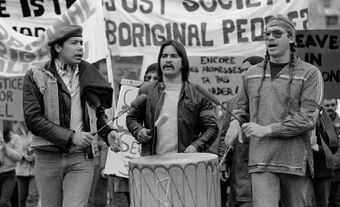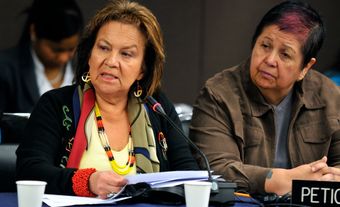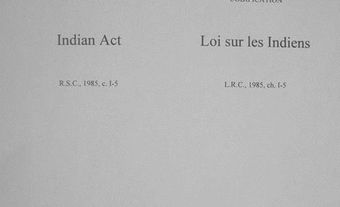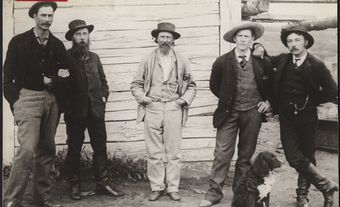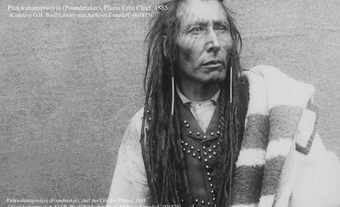The Indian Act is the primary law the federal government uses to administer Indian status, local First Nations governments and the management of reserve land. It also outlines governmental obligations to First Nations peoples. The Indian Act pertains to people with Indian Status; it does not directly reference non-status First Nations people, the Métis or Inuit. First introduced in 1876, the Act subsumed a number of colonial laws that aimed to eliminate First Nations culture in favour of assimilation into Euro-Canadian society. A new version of the Act was passed in 1951, and since then, has been amended several times, most significantly in 1985, with changes mainly focusing on the removal of discriminatory sections. It is an evolving, paradoxical document that has enabled trauma, human rights violations and social and cultural disruption for generations of Indigenous peoples.
This is the full-length entry about the Indian Act. For a plain language summary, please see Indian Act (Plain Language Summary).

Historical Context: Before the Indian Act, 1763–1876
The Royal Proclamation of 1763 laid down the basis for how colonial administration would interact with First Nations peoples in the centuries that followed. The Proclamation guaranteed certain rights and protections for First Nations peoples, and established the process by which the government could acquire their lands. Further policies were passed in the first half of the 19th century that aimed to assimilate First Nations peoples into the growing settler population.
The 1850 Act for the better protection of the Lands and Property of the Indians in Lower Canada was one of the first pieces of legislation that included a set of requirements for a person to be considered a legal Indian — a precursor to the concept of “status.” These requirements were based on blood, and essentially said that people “shall be considered as Indians” if they were of “Indian blood” and were members of a “Body or Tribe of Indians.” All descendants of such people were considered to be Indian. So too were non-Indians who “intermarried with such Indians,” people whose parents (one or both) would have been considered Indians, and “all persons adopted in infancy by any such Indians.”
The Acts commonly known as the Gradual Civilization Act of 1857 and the Gradual Enfranchisement Act of 1869 were primarily aimed at removing any special distinction or rights of First Nations peoples in order to assimilate them into the larger settler population. This was initially meant to be accomplished by the Gradual Civilization Act through voluntary enfranchisement (i.e., a First Nations person would give up their status in exchange for land and the right to vote), but only one person voluntarily enfranchised. As a result, the government then began unilaterally enfranchising First Nations people.
A number of Indigenous groups made treaties— in particular the first five Numbered Treaties — with Canadian governments before the 1876 passing of the Indian Act. Those groups may consider their legal identity as First Nations people to flow through those treaties, rather than through the Indian Act.
The Indian Act Comes to Power, 1876
In 1867, the Constitution Act assigned legislative jurisdiction to Parliament over"Indians, and Lands reserved for the Indians." Nearly 10 years later, in 1876, the Gradual Civilization Act and the Gradual Enfranchisement Act became part of the Indian Act. Through the Department of Indian Affairs and its Indian agents, the Indian Act gave the government sweeping powers with regards to First Nations identity, political structures, governance, cultural practices and education. These powers restricted Indigenous freedoms and allowed officials to determine Indigenous rights and benefits based on “good moral character.”
The Indian Act attempted to generalize a vast and varied population of people and assimilate them into non-Indigenous society. It forbade First Nations peoples and communities from expressing their identities through governance and culture. The Act replaced traditional structures of governance with band council elections. Hereditary chiefs — leaders who acquire power through descent rather than election — are not recognized by the Indian Act. Until 1951, women were also excluded from band council politics. (See also Women and the Indian Act.)
The Act also made it illegal for First Nations peoples to practice religious ceremonies and various cultural gatherings. In 1884, the potlatch was banned, and in 1895, “any Indian festival, dance or other ceremony,” which would include powwows and the sun dance, were also banned. Another amendment in 1914 outlawed dancing off-reserve, and in 1925, dancing is outlawed entirely.
In 1927, the Act made it illegal for First Nations peoples and communities to solicit funds for the pursuit of a land claim. Subsequent amendments required First Nations children to attend industrial or residential schools(1894 and 1920). The dark legacy of residential schools in Canada has affected Indigenous communities across the country and intergenerationally.
At the turn of the 20th century, the pass system (which restricted the movement of First Nations peoples off reserves) was imposed without any legal authorization. These restrictive policies have had lasting impacts on generations of Indigenous people, as restrictions on mobility caused damage to Indigenous economies, cultures and societies.
The Indian Act also defined who was considered an Indian under the law. It stated that an Indian was “any male person of Indian blood reputed to belong to a particular band.” Indian status also applied to “any child of such person” and to “any woman who is or was lawfully married to such person.” A person lost status if they graduated university, married a non-status person (if they were a woman) or, from 1876 to 1880, became a Christian minister, doctor or lawyer. This was known as enfranchisement. Section 112 of the Indian Act – known as the “compulsory enfranchisement” section — wasn’t removed until 1961. The administration of status was a tool of assimilation and cultural destruction.
A Revised Indian Act in 1951
The period immediately following the Second World War involved much societal introspection in Canada, and led to a reconsideration of some of the more restrictive and oppressive measures imposed by the Indian Act. A series of proposed reforms were rejected or opposed by First Nations peoples because they were not involved in the process. As a result, the government of Canada broke with tradition and through the Joint Committee process, consulted with First Nations communities for the very first time ever about changes to the Indian Act.
A new and revised Indian Act was given royal assent on 20 June 1951. The resulting overhaul removed some of the most offensive political, cultural and religious restrictions. For example, bans on ceremonies like the potlatch and sun dance were removed. Communities were also able to bring about land claims against the government. For First Nations women, the 1951 Act meant they were now able to vote in band council elections. Elsie Marie Knott was the first elected female First Nations chief in Canada. (See also Indigenous Women and the Franchise.)
However, the revisions did not rid the Act of discrimination. For example, the Indian Act prohibited status people from possessing intoxicants or being intoxicated. The 1951 revisions also gave the provinces jurisdiction over Indigenous child welfare (Section 88) where none existed federally. This eventually allowed for the “Sixties Scoop” to occur, a process by which provincial child welfare agencies chose to remove children from their homes rather than provide community resources and supports. The Sixties Scoop has had considerable and long-lasting effects on Indigenous communities.
Moreover, the new Act did not overturn the discriminatory nature of Indian Status. The Act replaced the concept of “Indian blood” with one of status through registration. In other words, simply having First Nations heritage was not enough to qualify for status. Yet, male lines of descent were still privileged; women with status lost their rights if they married a non-status person. (See also Women and the Indian Act.)
The provisions regarding a woman’s status were particularly extreme. A woman’s status rights flowed entirely through her husband. A non-status woman who married a man with status would gain status herself. A status woman who married a status man had her band membership tied to his so she was no longer a member of her own band, and she lost her status entirely if she was widowed or abandoned by her husband.
The 1951 Indian Act also introduced the “Double Mother” rule, which revoked a child’s status on its 21st birthday if both their mother and grandmother had not qualified for status. The Royal Commission on Aboriginal Peoples in 1996 noted that the revisions contained in the 1951 overhaul did little but return the Indian Act to its 1876 state, while the additional restrictions on the transfer of status did harm to First Nations women and their children.
Demanding Change to the Indian Act, 1960s and 1970s
The 1951 Indian Act did not alter the process of enfranchisement for Indigenous peoples, nor did it allow for the right to vote. However, in early 1958, Prime Minister John Diefenbaker’s government began drafting the Canadian Bill of Rights. With the Bill of Rights’ emphasis on equal rights for all Canadians, Indigenous peoples could hardly be denied the right to vote. On 31 March 1960, portions of Section 14(2) of the Canada Elections Act were repealed in order to grant the federal vote to Status Indians. First Nations people could now vote without losing their status. The following year, the compulsory enfranchisement clause in the Indian Act was removed. (See also Indigenous Suffrage in Canada.)
In 1969, the government of Prime Minister Pierre Elliott Trudeau released its White Paper, which declared its intention to entirely eliminate Indian status and the Department of Indian Affairs. The White Paper was met with outrage from First Nations peoples and was immediately countered by the “Red Paper,” created and presented by Harold Cardinal, then-president of the Indian Association of Alberta. Due to the fierce and continued opposition by Indigenous groups and their supporters, the Canadian government quickly withdrew the White Paper.
Many Indigenous women during this time were fighting to change discriminatory sections of the Indian Act. Mary Two-Axe Earley was one of the earliest activists. In addition to other work, she mobilized a series of speaking and writing campaigns to raise the profile of abuses by women who had been denied status, treaty and property rights under the Act. Yvonne Bédard and Jeannette Corbiere Lavell, both of whom lost their status because of a marriage, brought cases to court against the Canadian government. In 1973, their cases merged at the Supreme Court of Canada. In that year, the court was widely criticized for ruling that the part of the Act that connected a woman’s status to her husband’s did not discriminate against women, even though status men kept their status if they “married out.” (See also Bédard Case and Lavell Case.)
In 1981, the United Nations Human Rights Commission ruled that Canada had violated Article 27 of the International Covenant on Civil and Political Rights in the case of Sandra Lovelace Nicholas— a Wolastoqiyik woman who had lost her status through marriage. The government had prevented Sandra from returning to her home community because, according to the Indian Act, she had married out and was no longer considered to be a band member.
Bill C-31: 1985 Amendments to the Indian Act
In 1985, responding to growing national and international concern over the lack of equality in the Indian Act, the government passed Bill C-31. The bill fully removed all remaining enfranchisement clauses. Additionally, those who had lost status through marriage were reinstated as Status Indians and as band members. Their children gained status, but would not gain band membership for two years. This interval was meant to give bands time to create their own membership codes, which could exclude the children, but not their mothers. If such a code was not passed prior to June 1987, the children gained band membership as well. With more control over membership lists, bands could have non-status members. However, since funding through the federal government is based on status members, there is little incentive for bands to have many non-status members.
Since the amendments to the Indian Act in 1985 were put in place, the number of registered Indians has more than doubled, from approximately 360,000 in 1985 to more than 778,000 in 2007. The increase is a result of more births over deaths as well as through "reinstated" Indian status.
However, while the amendment addressed discrimination against women, it also created some problems. Bill C-31 created two categories of Indian registration. The first, known as section 6(1), applies when both parents are or were entitled to registration. (This section is further broken down into sub-sections that differ based on how status is passed down.) The second, known as section 6(2), applies when one parent is entitled to registration under 6(1). Status cannot be transferred if that one parent is registered under section 6(2). In short, after two generations of intermarriage with non-status partners, children would no longer be eligible for status. This is known as the “Second-Generation Cut-Off” rule. In this way, Bill C-31 has had consequences on the number of people entitled to status rights.
Governance and the Indian Act, 1960s to 2000s
The Indian Act, 1876, dismantled traditional systems of governance and imposed external controls — in the form of local Indian agents and the federal bureaucracy of the Department of Indian Affairs on individuals and communities. Not until the late 1960s and early 1970s did increasingly effective political organizations and intensifying activism set Canada on a path toward acknowledging and enabling forms of Indigenous self-government. This trend gained momentum in the late 20th and the early 21st centuries, and Indigenous peoples saw their rights to self-government affirmed in theConstitution Act, 1982, and in international documents.
In 1984, the James Bay and Northern Quebec Agreement, as well as the Penner Report, resulted in the Cree-Naskapi (of Quebec) Act, the first piece of Indigenous self-government legislation in Canada, which replaced the Indian Act and established Indigenous communities in the region as corporate entities. Self-governing First Nations are not subject to the Indian Act, though the federal government continues to administer certain First Nations affairs.
Since then, there have been proposals to increase band powers over governance in the Act. In 1996, the federal government proposed Bill C-79 to amend areas of the Act including band governance and the regulation of reserves. The majority of First Nations were opposed to Bill C-79. Among other reasons, they argued that the government failed to adequately consult with First Nations about proposed changes. They feared the bill would threaten treaty rights and the right to self-government. Furthermore, the bill was criticized for ignoring the recommendations of the Royal Commission on Aboriginal Peoples. Bill C-79 failed to become law.
In 2002, Bill C-7, also known as the First Nations Governance Act, sought to give band councils more power in terms of law-making, leadership selection and the like. Though the federal government consulted with various First Nations about the bill, it ultimately failed. In 2006, Senator Gerry St. Germain introduced Bill S-216 “to promote the recognition and implementation of the right to self-government for First Nations in Canada.” The bill would have allowed for First Nations wishing to self-govern to develop a proposal and constitution. While Bill S-216 achieved Second Reading, it too ultimately failed. (See also Parliamentary Procedure.)
However, some First Nations have made successful sectoral arrangements. These allow for greater governance powers not provided under the Indian Act. Some examples include: First Nations Land Management Act (1999), First Nations Fiscal Management Act (2005), First Nations Oil and Gas and Moneys Management Act (2005), First Nations Commercial and Industrial Development Act (2006), and First Nation Property Ownership Act (2009).
Amendments to the Indian Act in 2011 and 2017
Despite various amendments, the Indian Act still discriminated against women and their descendants, with regards to status rights. In 2011, Parliament passed the Gender Equity in Indian Registration Act, also known as Bill C-3. This was federal government’s response to the McIvor case, which was about gender discrimination in section 6 of the 1985 Indian Act. Bill C-3 grants 6(2) status to grandchildren of women who regained status in 1985. However, the descendants of women, specifically in terms of great-grandchildren, did not have the same entitlements as descendants of men in similar circumstances. Therefore, Bill C-3 still denied status rights to some individuals because of gender discrimination.
Bill S-3 was created in response to another court case about discrimination in the Indian Act, the 2015 Descheneaux case. The issue in this case was about the way status is passed to cousins and siblings. One part of Bill S-3 came into effect on 22 December 2017. Among other provisions, the amendment enables more people to pass down their status to their descendants and reinstate status to those who lost it before 1985. For example, it provides ways to register people with unknown paternity and who were unmarried minors between 1951–85 and affected by registration rules in place at the time. The other part of the bill — related to restoring status to women and their offspring who lost status before 1951 (known as the “1951 Cut-off”) — was brought into force on 15 August 2019. According to the government, “All known sex-based inequities in the Indian Act have now been addressed.”
Proposed Reforms
In 2010, the federal government announced its intent to work with Indigenous peoples to get rid parts of the Indian Act that give the authority to create residential schools and take children away from their homes.
Bill S-2, the Family Homes on Reserves and Matrimonial Interests or Rights Act, addresses a legislative gap in the Indian Act. It aims to ensure that people living on reserve have similar rights to marital property as other Canadians. According to the Canadian government, Bill S-2 is a stand-alone piece of legislation, not a part of Indian Act reform.
Debate: To Keep or Eradicate the Indian Act?
While some Indigenous and non-Indigenous peoples call for the abolition of the Act, others fear that its removal would erode certain protections, such as those on Indian Status. As scholar David Newhouse explains, “[The Indian Act] provides the structure for local community governance and community life. Reforming the Act in one fell swoop, or repealing it, would be enormously disruptive to First Nations.”
However, critics of the Act continue to work toward its dismantlement. These Indigenous peoples hope that the powers of the Act will fade or disappear with the increasing move towards self-government and reconciliation, contributing to a change in government-Indigenous relations. As Assembly of First Nations chief Perry Bellegarde stated in 2018, “We all want to move beyond the Indian Act’s control and reconstitute ourselves as Indigenous peoples and Nations with fundamental inherent rights.”
What is the Indian Act and why Canada still have it on the books? The Secret Life team looks at the roots of this complicated policy, which after 143 years is still embedded in Canadian identity, from the policy that led to the Act to how it still impacts Indigenous identities today.
Note: The Secret Life of Canada is hosted and written by Falen Johnson and Leah Simone Bowen and is a CBC original podcast independent of The Canadian Encyclopedia.
Legacy and Significance
Though it has been amended several times over the years, the contemporary version of the Indian Act still outlines the terms of Indian Status, various rules around reserves, financial guardianship of minors and the mentally incompetent, management of band resources, elections, and other aspects of life on a reserve.
The Indian Act has had ongoing and long-lasting impacts on Indigenous cultures, economies, politics, and communities. It has also caused inter-generational trauma, particularly with regards to residential schools, as the oppression and restrictive provisions of the Act have negatively impacted generations of Indigenous peoples.

 Share on Facebook
Share on Facebook Share on X
Share on X Share by Email
Share by Email Share on Google Classroom
Share on Google Classroom
